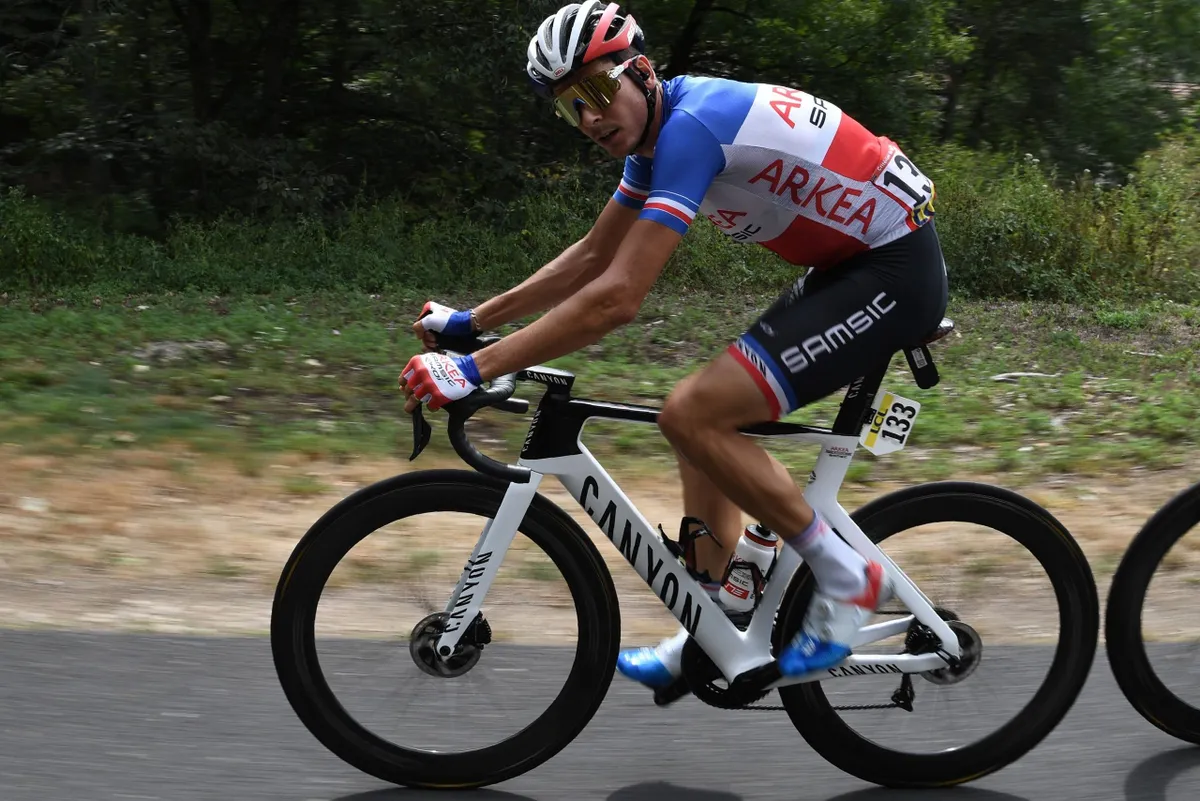Update 06/10/2020: The 2021 Canyon Aeroad has now officially been released. The original news story continues below.
We've spotted French national champion Warren Barguil riding what looks to be Canyon’s new Aeroad Disc aero road bike on stage one of the 2020 Critérium du Dauphiné.
Though the bike’s existence is perhaps one of the cycling industry's worst-kept secrets, the German brand nevertheless remains tightlipped about it.
It’s a bike that many of us here at BikeRadar were hoping to see in 2020, but it has so far only made a handful of fleeting appearances in the wild; once in an advert for Zwift (featuring another of Canyon's sponsored stars, Matheiu Van der Poel) and at a select few professional races.

The Zwift advert, released in January 2020, showed XC, cyclocross and road superstar Van der Poel riding a number of different Canyon bikes on a Wahoo Kickr smart trainer, in a room with Zwift projected onto the walls.
His road bike appeared to be an updated version of the Aeroad, Canyon's highly regarded but slightly long-in-the-tooth aero bike.
Other than a different paint job (Barguil rides for Arkéa-Samsic, whereas Van der Poel riders for Alpecin-Fenix – both teams are sponsored by Canyon), the most recent photograph of Barguil at the Dauphiné doesn’t appear to show any external differences to the bike Van der Poel used in the Zwift advert.
Though we can’t be certain, we might speculate this means the bike could finally be ‘oven-ready’ and therefore due to be released sooner rather than later.

A clearer picture of what's coming
The latest images, taken during the race by photographer Anne-Christine Poujoulat, do provide a good look at many of the finer details though.
From the side profile, we think it looks quite a lot like the recently #cancelled Specialized Venge, though perhaps Canyon would say the Venge looked a lot like the current Aeroad Disc.
While the overall profile of the frame appears similar to that of the current model, originally released back in 2014 and updated with disc brakes in late 2016, there are a few notable differences when the two bikes are compared side by side.
For a start, the cable routing around the handlebars and head tube has been significantly tidied up, with all cables (including hoses for hydraulic disc brakes) now routed fully internally through the handlebar and into the frame.

The handlebar also looks to have received an update, with the traditional-bend drop shape found on the previous model being replaced by a more modern, semi-compact shape.
Additionally, the seatstays appear deeper and the new fork also tapers less at the dropouts than the previous version. Both are perhaps taking advantage of the updated UCI rules, which now permit tube shapes that are slightly longer and thinner (and therefore more aerodynamic) than when the original version of the Aeroad was released.
The seatstays also appear to be sculpted to help hide the rear disc rotor from the wind.

The down tube appears to be wider (and possibly deeper), to match the head tube, likely to increase stiffness and improve aerodynamic performance (potentially with water bottles in place – similar to how Pinarello widened the down tube when redesigning its F8 to make the F10).
Tyre clearance at the fork looks to have also increased, which would be a welcome update.
Being able to take a 28mm tyre was considered very progressive for an aero road bike when the current Aeroad released, but times have moved on and we're hoping this new version might be able to take even larger road tyres.

The proprietary aero seatpost also appears to have been significantly beefed up, presumably in search of greater aerodynamic efficiency, but we’ll be interested to find out how comfort compares to the current model when we can eventually get one in to test.
It's difficult to speculate on the weight of the frame, particularly as some of the tubes appear to have got bigger. However, if a pure climber like Barguil was happy to use it for a stage that included plenty of climbing, with 60mm deep Shimano Dura-Ace wheels, it surely can’t be too weighty.
Clearly a favoured test pilot, Braguil has also been riding a ‘new Evo’ version of Canyon's Ultimate frameset recently, though we now believe that to be the 641g CFR version announced earlier this week.

It’s also notable that we’ve still not seen hide nor hair of a rim brake version of the new Aeroad. The latest update to the UCI’s list of approved frames and forks also still appears to only list a disc version of this new model (the Aeroad CFR Disc R065).
It might upset a few die-hard rim brake fanatics out there, but that appears to be the clear direction the performance road bike market is now heading.

